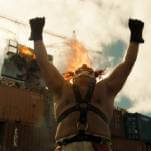Each week, Big Issues focuses on newly released comic books of significance. This week, it’s The Fade Out #7. Written by Ed Brubaker (Velvet, Criminal) with art by Sean Phillips (Criminal, Sleeper) and Elizabeth Breitweiser (Velvet, Outcast), this issue deepens the mystery at the series’ core with a steamy romantic getaway for the central character. (Note: This review reveals major plot points.)
After over a decade of stellar collaborations, Ed Brubaker and Sean Phillips have become one of the most reliable teams in comics, consistently delivering exciting, tense, character-driven stories overflowing with style and atmosphere. These two creators bring out the best in each other, and The Fade Out is shaping up to be their most riveting work yet. A crime-noir series set in post-World War II Hollywood, The Fade Out has a heightened level of glamour that distinguishes it from Brubaker and Phillip’s gritty previous projects, but that doesn’t mean it shies away from the darkness within its characters. The story captivates by gradually revealing the corruption and depravity hiding behind the bright lights, and that balance of extravagance and deviance is key to the book’s success.
Much of Brubaker’s narrative deals with the personal ramifications of the blacklist and the restrictive climate created by the Hays Code, but The Fade Out #7 doesn’t spend much time on the political conflicts that made post-WWII Hollywood such a heated environment. Instead, it focuses on screenwriter Charlie Parish’s budding romance with Maya Silver, the up-and-coming starlet appearing in his new film, highlighting the passion and intrigue that draws them closer. Charlie is at the center of this series, but the last few issues have shifted away from him to flesh out the rest of the steadily expanding ensemble, drawing the reader further into the plot by showing more sides of the story. Those perspectives are important, but Charlie’s is the one that concerns the book’s key mystery most heavily. Eventually, the specter of the murdered Valeria Sommers creeps its way into Charlie and Maya’s romantic getaway.
Charlie found Valeria dead in the first issue of The Fade Out with no memory of the events leading up to her demise, and his role in the murder is slowly becoming clearer. As he begins a relationship with another beautiful young blonde actress, the sins of his past are starting to weigh on his conscience and influence his behavior, bringing out the impulsive, violent side of Charlie that was built up during the war. His time with Maya starts off as a lusty, alcohol-fueled retreat, but eventually he realizes that this is all a distraction from problems he can’t escape, and that just makes him angry. So angry that when he’s threatened by a disgruntled writer colleague at a bar, Charlie goes into a berserker rage and threatens to kill everyone in the establishment.
Seeing Charlie’s fury immediately raises concerns about what happened that night with Valeria, and he gets closer to learning the truth when he tends to his wounds in the bar bathroom after his outburst. That’s where he meets Drake Miller, the producer who Charlie remembers from the night of Valeria’s death. The first shot of Drake is from the Charlie’s point of view, and his newly cracked glasses distort Drake’s face to visually indicate that there’s something off about the silver-haired man with the wide grin. Drake puts up a friendly front, but he speaks in veiled threats, and Charlie’s paranoia immediately catches on to Drake’s not-so-subtle clues that he has information that could be potentially damaging. The mystery deepens with Drake’s introduction, and Maya’s final line is a cheeky tease from Brubaker that things are going to get much worse for Charlie: “Writers are supposed to be boring… don’t you know that?”
Sex is a big element of Brubaker and Phillips’ work, and they understand that sexual chemistry between characters is a great way of strengthening their relationship when used effectively. The Fade Out #7 features some very steamy sex scenes, but they provide far more than just titillation. A two-page sequence juxtaposes bittersweet narration with images of Charlie and Maya pleasuring each other, drawing attention to the fact that Charlie is using sex as a way to flee from larger issues. That strategy works because he’s able to lose himself in the intimacy, an immersion that is emphasized by Phillips including two different shots of Charlie and Maya in the panels.
In the foreground, Charlie and Maya are in full-color and their sexual conduct is explicit: Maya reaches down Charlie’s pants and gives him a blowjob; then he penetrates her from behind. The foreground is the reality of their sexual experience, but the background is the Hays Code-Hollywood fantasy of their coitus, a much softer and more conservative, but still very passionate, series of black-and-white images. Those background shots are still a little too racy to actually appear on screen back in the late ’40s, but they are a clever way of intensifying the romance of the scene and provide a tasteful balance to the more provocative imagery in the foreground.
Those background images have a smoother, dreamier look because Phillips smudges the linework, one of the ways he’s taken advantage of the shift to digital rendering to play around with his style. That change has made Phillips’ art even tighter than before, and being able to easily switch between tools and work on different layers of artwork is likely the reason why his work on this book is even more rich and detailed than usual. A lot of artists that jump to digital lose specificity in their artwork, but Phillips doesn’t take any shortcuts on The Fade Out, maintaining his signature grit even as he details the sensational world of Hollywood. Phillips’ transition to digital is barely noticeable if you’re not looking for it, but it has greatly benefited the book and made the visuals all the more immersive.
Colorist Elizabeth Breitweiser joined forces with Brubaker and Phillips two years ago, and she’s quickly become an essential part of the team with her textured rendering style and evocative palettes. The bright pastels of The Fade Out are largely responsible for the vibrant look of Hollywood, and those creamy, sunny colors interact beautifully with Phillips’ densely shaded linework. Her coloring gives a glow to the settings and characters, creating the impression that this world is constantly lit by either the sun or set lights, which isn’t always a good thing. It’s easier to hide in the darkness, and that constant light threatens to expose the shadowy figures that populate this series. That persistent brightness also makes scenes with more muted colors stand out, like Charlie and Maya’s post-coital conversation that reveals more about Maya’s past. The scene is drenched in shades of cool blue that evoke the issue’s title, “The Sound Of Waves,” and the final shot of that sequence is a serene image of the full moon above the ocean outside their window.
Like many Image ongoings, The Fade Out features extra content in each single issue to make the floppies more attractive, and Devin Faraci’s essays on Hollywood’s dark past are often as thrilling as the main story. This issue’s piece on Errol Flynn’s raging libido and one of his trials for statutory rape is another fascinating glimpse into the true stories that set a real-world foundation for this fictional crime tale, and it’s accompanied by a stunning illustration that showcases Phillips’ remarkable ability to channel the spirit of these famous figures in his artwork.
From the front cover showing Maya in Charlie’s arms to the back cover showing an image of Ray Milland and Jessica Towne in Charlie’s breakout film “At The End,” The Fade Out #7 pulls the reader deeper and deeper into the world of these characters. Committing to a single location and time period is a big reason why this series has so much depth, and the creative team is able to take its time and build up the characters and their relationships before making the big plot developments. It’s a slow-burning, original ensemble drama the likes of which these collaborators haven’t really attempted in the past, and trying something different has only improved an already outstanding partnership.







































